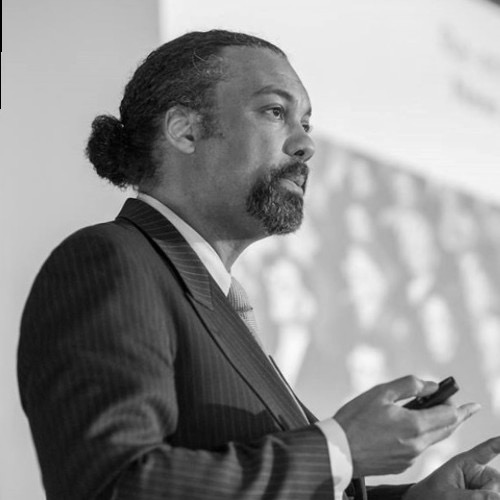In countries like China, the camera on a smartphone isn't just for fun selfies -- it's an everyday practical device, for everything from banking to shopping. Michael Agustin wants to fast track this sort of adoption in the west by giving retailers AR IoT technology with Curie.
Alan: Hey there, it's Alan Smithson with the XR for Business Podcast. And today we're speaking with Michael Agustin, co-founder and CEO of Curie. They're an augmented reality shopping platform that enables consumers to make better purchasing decisions quickly and visually. All that coming up on the XR for Business Podcast.
Michael, welcome to the show, my friend.
Michael: Thanks for having me on.
Alan: I'm so excited. We had the opportunity to meet recently at., well, these two things, really. It was the VRARA gathering in San Francisco, and then we went from there to Verizon's head office and we went for a meetup where we learned from Apple and a bunch of other people about what's coming up in virtual reality. So it was really great to meet you in person. I want to unpack what you've been doing, but let's talk about what is Curie? We're Curie-ous.
Michael: Yeah. So I see that you're AI-curious. So Curie is an AR shopping assistant that allows people to make decisions very quickly. This sort of ties in to the journey of any customer that is looking to make a purchase about any type of thing. So we're kind of giving people this on-screen HUD, to be able to make decisions on the fly about any different type of product, especially the ones that they would want to save money on. And it also enables retailers to sort of keep other apps from participating in show-rooming in their stores. So we're looking at big box stores by giving them the powers of augmented reality and enabling all of the same tools that shoppers would typically have online, offline. So things like online reviews and movies and people who bought this also buy these things.
Alan: That's really interesting. I think it's it's something that's coming really quickly. And, you know, you guys have listed on your website that you're computer vision company. Walk me through the consumer experience of this. So I have my phone. I'm in a store. I point my phone at a pair of shoes. It recognizes the shoes and says, here's some Amazon reviews on it -- or some reviews from that store, I guess -- and then here's some other things that you might like that aren't necessarily in the physical store, correct?
Michael: Yeah. So typically, you don't have these tools available to you offline. The reason why we say we're a computer vision company is that computer vision is like G.P.S. for your camera. So think about all the times you use G.P.S. and Waze and Yelp and Google Maps. We're doing that from a first-person perspective and providing the ability to sort of connect to things that are in front of you, via services and information. The reason why you would want to do this is that information is typically still not in front of you when you need it, but it's available online. So we were named after Marie Curie, who sort of dedicated her life to seeing what was invisible. And we would argue that right, now information is invisible, and you can't really see it when you need it on top of things.
Alan: Amazing. So are there any companies actively deploying this now, or is this still in early phases, or where were you in the food chain of startups?
Michael: So our lead investor is 500 Startups, and we are gaining customers through a program that's backed by Wal-Mart and Sam's Club and Tyson. We're talking to several OEMs and other types of retailers about incorporating our technology into their shopping apps.
Alan: Interesting, that's really cool. So how does it work from a business standpoint, if I want to sign up for this? Let's just take a company... I sell electronics online, or online and in-store, and I want to incorporate this. What is the process look like?
Michael: So typically, we target companies that have access to, or have built, an API, and then that API has access to things like reviews and content that we can just display as sort of like an on-screen HUD within your phone or smart glass. And that enables their shoppers to get the information that they typically would have gotten from an app or website, but affixed to the products that they see within a store. So we're looking to put, like, an AR into companies like Wal-Mart.
Alan: That'll be really cool. So basically, I'm in the store and I see the blender. I point my phone in the blender, it goes, "Oh, this is the XYZ blender." And it gives me the reviews around it, and basically augments that physical box in the stores, correct?
Michael: Yeah.
Alan: Then I can order it right from there, and I don't even have to take it home. They just they ship it to my house, and then I can go on with my day.
Michael: Yeah. Yeah. This concept is called New Retail, which was sort of coined by Jack Ma of Alibaba. Stores in China are very experiential and sort of future-facing. You would be able to just point your camera at a product, buy it, and have it ready for you in two hours.
Alan: I love that. It's super good. It's kind of like what Samsung is doing here by building their experience centers. You can't really... I don't even think you can buy the phone in the center. It's just for experiencing, learning. And then you can buy everything online. So that's exciting.
Michael: Mm hmm.
Alan: So what else do you want people to know about this product?
Michael: So I think that's the biggest thing to communicate, is how this kind of fits within your regular day. In China, QR codes are scanned a quarter-trillion times every year, and you can't really go about your day without using your camera. I think in the US and in the West, people kind of still see their camera as more of, like, entertainment as opposed to something that they can use practically like a credit card. Our goal is to try to bring that consumer behavior to the United States.
Alan: I find it really strange that we do so many things with our phones, everything from checking the weather to... just unlimited things with our phones. And yet we don't tie the camera to a real world very often. And I think... the idea of the QR code in North America, I don't know. I don't know what happened. We just missed out on it. And my daughter, a few years ago, kind of made it clear to me why, and how we build on this. She said, "well, why would I point my phone at a QR code to take me to a Web site that's listed underneath? Why wouldn't I just type in the website? I was like, "well...?" Because in China, they offer discounts that, you know, they really built a culture around pointing your phone at the QR code. You can pay for things and all that. How do you think we're gonna kind of get that culture over here?
Michael: Well, I think it's important to understand it's adoption of the technology. So the reason why China had a head-start is that, as difficult it is for someone in the West to understand Chinese? It's the reverse. Most of the Internet and the Web are written in Western languages. So the ability for the average Chinese citizen to look at something wasn't there. They couldn't memorize it. And two, rural China was unbanked. And so there were no credit cards. There was no Visa or MasterCard. So the only way to pay for something was their mobile phone. Their phone became their wallet. And that enabled QR to be adopted faster. And in addition to to that, companies like Alibaba and WeChat spent a lot of money educating the market and integrating themselves into every facet of society, from retail to advertising. And so so I think the way to bring that to the states is using the concept of a default effect, meaning that in any given situation, you have the advantage of using it. And so what we're looking to do is work with retailers and OEMs to bring Curie to their apps and devices. Just like what Alexa is to the microphone, we're looking to bring to the camera.
Alan: Well, you're no stranger to digital worlds, and in fact, your previous company, it was quite successful. You want to touch on that a bit?
Michael: Yeah. I founded a company called Game Salad, which was a tool that you could download to your desktop to be able to make iPhone and Android games. What we effectively did was we enabled the 99 percent who could not code to reach what is now 140-billion GMV marketplace of app stores, where 66 percent of engagement on mobile phones were games. And so that enabled a whole new type of creator economy for everyday folks and folks in emerging markets, to be able to make their own games without needing to hire a programmer.
Alan: That's amazing. You've had massive success with that. There's been millions and millions of games consumed with your Game Salad platform.
Michael: Yeah, about 10-million games have been generated from millions of creators hitting 100-million players per month. At one point I think we were 21 percent of games being uploaded to the App Store. So that's roughly equivalent to a WordPress.
Alan: That's incredible, man. And you're taking all of that experience and all that knowledge and moving towards the future of how we buy things. The future of e-commerce. I guess not even e-commerce. It's commerce in general. Retail. It's exciting.
Michael: Yeah.
Alan: What was the decision to kind of move from games to retail?
Michael: I was getting a lot of inbound for AR projects. And I think that what was missing for all of these projects was the AR. And so we attempted to create a company that just like how we made computer games accessible to the 99 percent to create. We wanted augmented reality accessible for the 99 percent of brands and retailers to be able to make use of. And the number one thing that is available everywhere are products. There's literally a hundred thousand things in any given place. And the statistics of you encountering that product is very high over and over again. And so we wanted to use that reproduction of things as almost like an information highway, creating a web across the things that we see, and being able to access the information when you needed it.
Alan: Well, right now, there's not any retailers rolling this out, right? So you're still kind of working on that. Who is your ideal customer? And if they're listening, how can they reach out to you?
Michael: Our ideal customers have been companies that are in retail, that have been wanting to sort of digitize their local stores. So we've been starting with the big ones to be able to prove it at scale. We're one of the few technologies that can do that without spending lots of money on, say, like an Amazon Go implementation, or electronic shelf labels, which could cost you hundreds of millions of dollars. This effectively reproduces the QR code, but in physical spaces and virtually. So you don't have to place stickers everywhere in order to get it to work. You just point your camera at things and start attaching information to it for shoppers to be able to consume.
Alan: So how are you training that? For example, if I look at a box. A box is easy, because you've got four sides, or whatever, six sides to it, and your phone can recognize those. But how are you doing something like a piece of clothing or something that may not be detectable as easy by computer vision?
Michael: So we are a hybrid solution. We also look at positioning. So just in case, we also tag the area in which that piece of clothing might be in. And so you'd be able to recall the information. It's sort of comparable to digital signage, but completely virtual.
Alan: And in these times of quarantines and self-solitude here, I guess that gives you guys a really good opportunity to really work on the tech and get some sales. And when people are ready to get back to shopping in the real world, I think this is gonna be a great tool.
Michael: Yeah, I think it's now needed more than ever. For these companies to be able to digitize, to know whether something is going to be on the shelves when you get there. You need to know whether or not a few companies are price gouging. You want to know whether or not you're getting the best prices. At the same time, you want to sort of practice social distancing. So maybe a store associate is not the best solution in this day and age. Maybe it's being able to access that information on your own. And so I think that these types of technologies can also help save lives.
Alan: I agree with you. What problem in the world do you want to see solved using XR technologies?
There's actually two problems that I was thinking of, where you'd want to be able to get at the table. One is invariably, the more that you create and affect perception, the more issues there are with privacy. And I think that that can be addressed by being able to keep information on the edge and local, so that no information's stored on the cloud. And if it is, it can be encrypted. And then two, is being able to use this technology to give other people a chance to access that information. About 300-million people are visually impaired, and you have other types of impairments like hearing. But you can convert information from one form to another if it's dynamic, if it's visual. And so I think that's a new way to kind of think about how to use XR; being able to synthesize data in a new type of mode that can be consumed by the people who really need it.
Alan: Well, that's a great way to think about it. And some great use cases there. Where can people find you?
Michael: Oh, we have offices in Austin and Seattle. So I'm from both areas. And the reason why I'm here in Seattle is that where there is oil, there are refineries; where there is data, there's AI. And so, yeah, I guess. Come check us out at Curie.co
Alan: That's C-U-R-I-E dot C-0.
Michael: Yeah.
Alan: Awesome. Well, thank you very much for joining. And that has been the XR for Business Podcast with your host, Alan Smithson. Today's guest, Michael Agustin from Curie. The future of retail is augmented reality.

Most kids who grew up spending too much time at the video arcade wound up with fewer quarters and a few earfuls from their...

Alan and his guests often espouse investing in XR on this podcast, but that comes with the implicit understanding that you should expect a...

Today’s guest — Sector 5 Digital‘s Jeff Meisner — hopes to put grave robbers out of business, among other things. He pops in to...